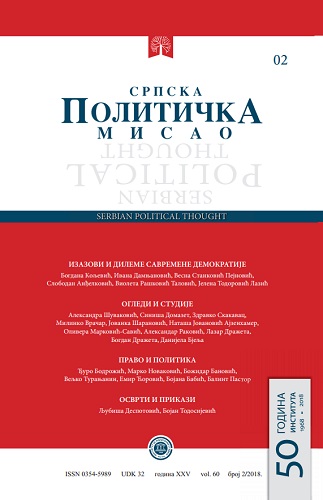Отцепљење Црне Горе (2006): новостечена, а не обновљена државност
The Secession of Montenegro (2006): New Statehood, Not Renewed Statehood
Author(s): Aleksandar RakovićSubject(s): Political history, Nationalism Studies, Transformation Period (1990 - 2010), Present Times (2010 - today), Politics and Identity
Published by: Институт за политичке студије
Keywords: Statehood; Kingdom of Montenegro; Serbdom; present-day Montenegro; anti-Serbdom
Summary/Abstract: Montenegro of the Petrović Njegoš dynasty (1697–1918), internationally recognized as an independent Princedom of Montenegro (1878), proclaimed Kingdom of Montenegro (1910), was the Serb state. Basic criteria of the Montenegro’s statehood, concluded with the Kingdom of Montenegro were Serbian population (95%), state territory with Metohija as sacred Serbian Kosovo-Metohija goal and Serbdom as state ideology. Elements of identity were the Serbian Orthodoxy, Serbian language, Cyrillic alphabet, while the symbols of the statehood were Serbian red-blue-white tricolour flag, two-headed white eagle as a coat of arms with roots in the medieval Serbian Nemanjić heraldry, people’s anthem “Onam’, onamo” known as the Serbian Marseillaise and currency perper named after currency of the medieval Serbian Empire. Two Serbian statehoods of the Kingdom of Montenegro and the Kingdom of Serbia merged in 1918 and then unified with other Serbs and Yugoslavs in the Kingdom of Serbs, Croats and Slovenes/ Yugoslavia. The Communist Party of Yugoslavia, after its victory in the WWII, established socialist Yugoslavia (1945–1991) as a federation of six republics. The People’s Republic/Socialist Republic of Montenegro still had Serbian tricolour flag but Montenegrins were officially considered separate ethnicity, known as “the different Serbs“. Although it was a dual identity, the door were opened for deserbisation, also led by the Roman Catholic Church and Croat ideologists who considered Montenegrins descendents of so-called “medieval Red Croats“. The break-up of the socialist Yugoslavia split Montenegrin identity into two parts: Serbs and Montenegrins. Serbs claimed Serbdom of historical Montenegro, while many Montenegrins – but not all – claimed Montenegrin roots within medieval Diocletia, considered by Croat ideologists a synonym to “the Red Croatia”. After Montenegrin president Milo Đukanović in 1997 accepted a path of separatism from joint state with Serbia, so-called “Diocletian ideology” became mainstream within the ruling elite. Montenegrin separatists, together with the minority population (Bosniaks, Albanians and Croats, together around 24% of Montenegro’s population) began to outvote Serbs (around 33% of Montenegro’s population) and Montenegrins of the Serbian mother tongue (still “the different Serbs”) with 55% against 45% on almost all elections and independence referendum (2006). During the process of secession and after secession of Montenegro, the ruling elite of Montenegrin separatists and ethnic minorities totally changed the identity of Montenegro. According to basic criteria, the Montenegro’s new statehood was claimed by the ruling elite just Montenegrin, in 2018 Montenegro sent troops to southern Serbian province Kosovo and Metohija to join occupying NATO forces, while serbophobia is considered main narrative. Elements of new identity are so-called “Montenegrin Orthodoxy”, “Montenegrin language”, Latin alphabet, while the symbols of the statehood are historical red military flag of the Kingdom of Montenegro now as a state flag, two-headed white eagle is now painted yellow, a version of a song “Oj svijetla majska zoro”, similar to one published in the book Red Croatia (1937) is accepted as a state anthem. The Kingdom of Montenegro and present-day Montenegro are two totally different states with the same name. There is nothing to connect them in basic criteria of the statehood, elements of identity and symbols of the statehood. The Kingdom of Montenegro had its Serbian statehood while present-day Montenegro has its Montenegrin statehood. Thus, secession of Montenegro in 2006 led to completely new statehood, and not renewed statehood.
Journal: Српска политичка мисао
- Issue Year: 2018
- Issue No: 2
- Page Range: 195-210
- Page Count: 16
- Language: Serbian

